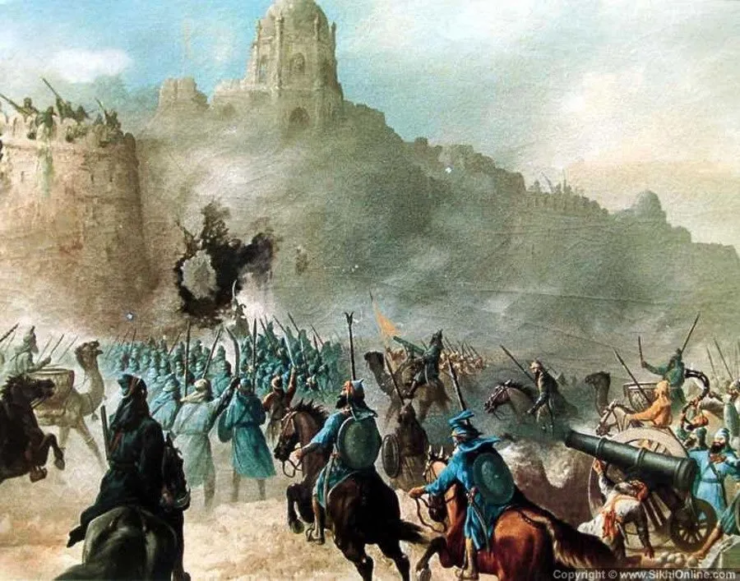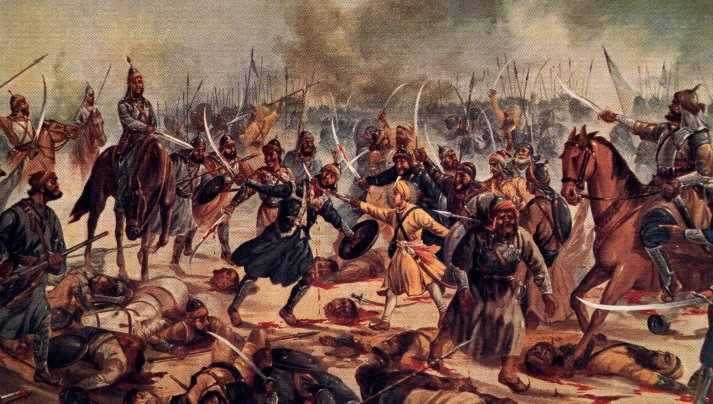
The Battle of Chamkaur changed the course of history in Punjab. It gave rise to one of the greatest military strategists – Banda Bahadur. He became so popular in Punjab that many people began calling him the 11th Guru of the Sikhs. Banda avenged the injustice done to Guru Gobind Singh and his family by the Mughals, providing the much-needed relief to the enraged people of Punjab, who were hurt and angry due to the treachery of the Mughals and the league of hill chieftains, which resulted in the martyrdom of all four sons of their Guru. Banda unified the community, providing a sense of pride with his military successes against the Mughals.
After the Battle of Chamkaur in 1704 December, Guru Gobind Singh regrouped his troops under Banda Bahadur, who conquered large parts of Punjab with his exceptional military strategies and the bravery of the people.
The Guru was betrayed by the Mughals and the hill chieftains. He was promised a safe passage to come out of the Anandpur Sahib fort after a seven-month siege. The Guru left the fort with his family on December 20 night. It was raining heavily. When they were crossing the Sarsa river, 25 km from the fort, they were attacked by the Mughals and their allies.
Guru Gobind Singh and his two sons along with 40 others took shelter in a house situated on a high ground, but they were separated from the mother and two younger sons of the Guru. The Mughals laid siege to the house, which was a Haveli with high mud walls. The Guru and his followers were exhausted and hungry due the siege of Anandpur Sahib fort as the supplies were cut off for seven long months. There was no ration and water in the fort.
However, the Guru and his men fought bravely from the Haveli situated in Chamkaur Sahib. No sooner than later, the Guru faced a situation wherein they would all end up dying as the 40 odd people would not last long against the mighty Mughal army. Therefore, the Guru decided to launch kamikaze-type missions and kill as many enemy soldiers as possible under cover of the raining arrows on the Mughal troops from inside the Haveli. About 30 people, including Guru Gobind Singh’s two sons, Ajit Singh (17) and Jujhar Singh (13), died in the battle in front of the Guru.
Decisive move
In the Haveli, Guru Gobind Singh was left with only 11 disciples. The disciples planned to rescue the Guru out of the battle zone, but he was not ready for that. However, they elected five of them as the Punj Pyaras who convinced the Guru to agree. The Guru could not reject their decision because it was laid out by the Guru himself while establishing the Khalsa force in 1699 that the ultimate power would be in the hands of the five chosen ones to take any decision regarding the community in a dire situation. In 1699, the Guru himself was baptised by the Punj Pyaras after they were initiated as the first five soldiers of the Khalsa army.
The Punj Pyaras decided that one of them, who looked like the Guru, would dress up as the Guru and would continue the fight as the Guru was taken away from the Haveli. The plan was successful. The Guru was rescued. The battle continued, killing everyone in the Haveli. The Mughals thought that the Guru had been killed, but he lived for another day.
But Guru Gobind Singh lost all four sons in a matter of days after coming out of the Anandpur Sahib fort. He witnessed Ajit Singh and Jujhar Singh dying fighting in the battle of Chamkaur, while both younger sons Zorawar Singh (9) and Fateh Singh (6) were interned alive in a brick wall by Sirhind Governor Wazir Khan after they were captured along with the mother of the Guru when they were separated from the Guru.

Guru’s Zafarnama
The Guru regrouped his soldiers and continued fighting the enemy in the following months after the battle of Chamkaur. He wrote a letter named Zafarnama to Aurangzeb, complaining about the Mughal forces breaking the promise of the safe passage. The proposal of the safe passage to the Guru, his family and his followers, along with negotiation for peace on honourable terms, was sent in the name of Aurangzeb.
The Guru tried to meet Aurangzeb, who died in 1707. The Guru met his successor Bahadur Shah in Agra. The Guru was promised action against Wazir Khan, but it remained another hollow promise. After that, the
Guru headed south. In Deccan, a Maratha empire was established by Chhatrapati Shivaji. In 1708, the exhausted Guru met Banda Bahadur, an ascetic, at his ashram in Nanded. The Guru stayed there with his followers. He emphasised the need to raise an army to defend the people of Punjab against the Mughal atrocities.
Early life
Banda Bahadur was born in Rajauri, Poonch, on October 27 in 1670 and was named Lachman Dev at that time. For being born in a Rajput family, he was taught hunting, horse riding, martial arts and weaponry at a very young age. During one of his hunting trips, it is said, he killed a doe that was pregnant with twins. He felt a sharp pang of remorse over the incident that made him an ascetic. He was only 15 years old at that time. In due course, he became the follower of a sadhu named Ram Das. Later, he began following another sadhu named Janaki Das, who renamed him Madho Das.
After meeting Guru Gobind Singh, Madho Das was baptised as a Khalsa soldier and named him Gur Bakhash Singh, but he became famous by the name of Banda Bahadur in the following years. The Guru appointed Banda Bahadur the chief of the Khalsa army.
Military expeditions
A few days after the death of Guru Gobind Singh in October 1708 due to the wounds caused by an attempt on his life, Banda Bahadur and his men started marching towards Punjab to wage a war against Wazir Khan. Before reaching Punjab, Banda Bahadur managed to gather an army of 40,000 men, including 4000 horsemen and 7800 men on the artillery. In 1709, he defeated the Mughal forces, led by Wazir Khan, in the Battle of Samana.
After capturing the city of Samana, Banda Bahadur’s troops gained access to the city’s huge wealth, which helped them become financially stable. Banda Bahadur then captured Mustafabad, Sadhora, Malerkotla, Nahan, and other Cis-Sutlej states of Punjab.
Wazir Khan killed
Wazir Khan, who was earlier defeated in the Battle of Samana, returned with reinforcements, which led to the Battle of Chappar Chiri in 1710. On May 12, Wazir Khan was killed in the battle. And Sirhind, an important Mughal territory in Punjab, was captured by the Khalsa soldiers. The territory, which extended from the Sutlej to Yamuna rivers, came under the control of Banda Bahadur. He established his capital at Mukhlisgarh and renamed it as Lohgarh.
Banda Bahadur started issuing his own mint at Lohgarh. He even sent his men to places such as Saharanpur, Jalalabad, and Muzaffarnagar to bring relief to the oppressed population there. Banda Bahadur continued to expand his territory by emerging victorious against the Mughals in the Battle of Rahon in 1710. Banda Bahadur’s victories and bravery inspired many people in Punjab to stand up and fight for their rights in places such as Jalandhar and Amritsar.

Zamindari system abolished
Besides being a great military strategist, Banda Bahadur was a great administrator. He removed the corrupt officials from important positions and replaced them with upright officials. He also abolished the zamindari system and bestowed complete ownership of the land on farmers, which made him very popular in the entire region.
Banda Bahadur was approached by the people from the neighbouring city of Sadaura for his help. This led to the Battle of Sadhaura, in which the Khalsa troops overpowered the Sayyids and Shaikhs and freed hundreds from the clutches of their evil landlords.
When a large area of Punjab came under the control of the Khalsa, the route between Delhi and Lahore was obstructed, which did not go down well with Bahadur Shah. Hence, he decided to deal with Banda Bahadur himself and directed his generals to join his army to defeat and kill Banda Bahadur. When Banda Bahadur was in Uttar Pradesh, the Mughal army led by Munim Khan captured Sirhind and the surrounding areas. However, the Mughals failed to find Banda Bahadur, which caused great concern to Bahadur Shah.
After Bahadur Shah’s demise in 1712, Farrukh Siyar became the Mughal ruler. He took up Bahadur Shah’s unfinished mission of capturing Banda Bahadur. He appointed Abdus Samad Khan as the governor of Lahore, hoping Samad Khan’s army would be able to subdue Banda Bahadur’s forces.
In March 1715, Abdus Samad Khan and his army succeeded in driving Banda Bahadur and his men into a village called Gurdas Nangal. They then laid siege to the entire village, which continued for eight months, weakening Banda Bahadur and his army. Abdus Samad Khan decided to lead his forces into the village on December 7, 1715 and managed to capture Banda Bahadur.
Tortured to death
Banda Bahadur and his men were locked up and tortured by the Mughal soldiers. He and his men were given two options – convert to Islam or face death. When they refused to convert, they were tortured. Banda Bahadur was tortured and publicly humiliated for three months. He was asked to kill his four-year-old son Ajay Singh. When he refused to do, the child was murdered in Banda Bahadur’s lap. The heart of the boy was cut out and thrust into Banda Bahadur’s mouth.
Various records state that Banda Bahadur was tortured beyond imagination before his death. His eyes were gouged out, limbs severed, and skin peeled using red-hot pincers. Banda Bahadur was executed on June 9, 1716. The death of Banda Singh Bahadur enraged many Sikh warriors, who vowed to carry forward the legacy of Banda Bahadur by standing up for their rights. Warriors like Sardar Budh Singh, Nawab Kapur Singh, and Baba Deep Singh kept the torch of the Khalsa burning, which played a major role in Sikhs dominating the region of Punjab. Years later, India’s tallest minaret Fateh Burj was built to honour Banda Bahadur.
Banda Bahadur, thus, established the first state ruled by the Sikhs in Punjab, though for a short period. But his initiative laid the foundation of a mighty Sikh empire under Maharaja Ranjit Singh in less than a century after he was tortured to death. In 2016, Prime Minister Narendra Modi commemorated Banda Bahadur’s 300th martyrdom anniversary.
-The writer is a Delhi-based freelance journalist who has been connected with the various national and international newspapers for three decades.








